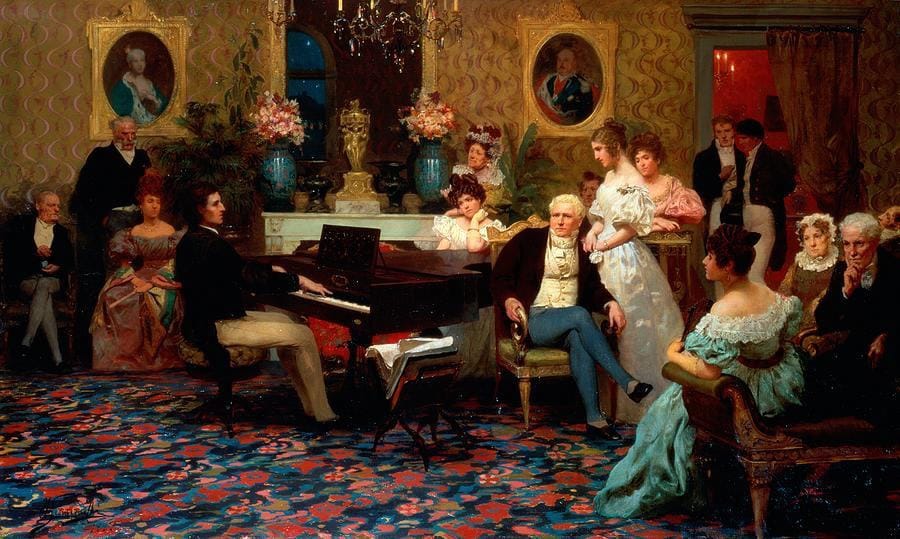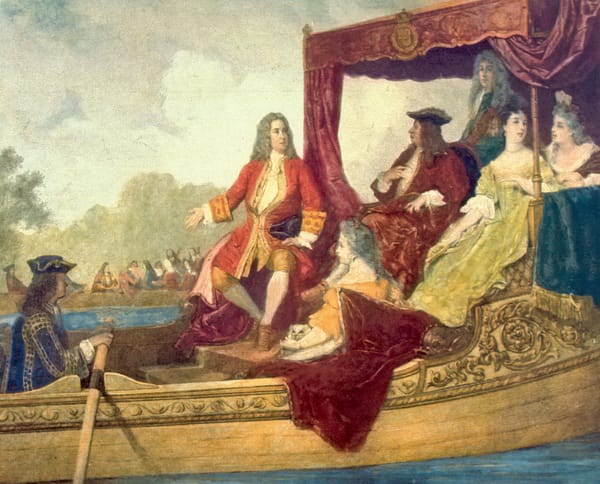The life of Chopin (and autographed piano)

The Chopin Foundation of the United States has in its possession a rare and unique item: a Pleyel piano with the autograph of Frederic Chopin. This well-travelled piano has touched many lives and resided in multiple countries, not unlike the man who signed it.
Beginnings
Frederic Chopin remained somewhat of an enigma throughout his life, and mystery surrounds even his birth. Although there is clear evidence that he was born in 1810, in the Polish village of Zelazowa Wola, the real day of his birth has been the subject of debate; some speculate that he was born on February 22nd, though Chopin himself stated that he was born on March 1st. His parents, Mikolaj and Justyna, were Franco-Polish. While Chopin expressed avid nationalistic views for Poland, his country of birth, it would be Paris where he would spend the majority of his life, Paris where he would experience the zenith of his career.
Chopin’s mother, a pianist of fair talent, introduced him to music at a very young age. When he reached the age of six, it was obvious to the family that Chopin had considerable talent and needed training of a more professional nature, so his father enlisted the help of a family friend, Adalbert Zywny, who turned out to be one of Chopin’s most, influential mentors. Oddly enough, Zywny was a violinist and only knew the rudimentary hand movements and fingerings for the piano. Chopin, consequently, received little formal training in the ways of the instrument. But perhaps it was this lack of instruction that inspired his distinctive style: Chopin was left alone to experiment with the mechanics of the piano, and so developed a method of drawing out the sound in a way that was entirely his own.1 Although such a process of learning was considered highly unconventional at the time, Chopin’s composition mentor, Josef Elsner, approved of the boy’s talent, and scolded a superior who criticised Chopin’s work:
Leave him in peace. His is an uncommon way because his gifts are uncommon. He does not strictly adhere to the customary method, but he has one of his own, and he will reveal in his works an originality which in such a degree has not been found in anyone.2
Elsner was not to be disappointed. Chopin quickly made his debut in society as both a composer and a pianist, playing his first published work, the Polonaise in G minor, at the salon of Countess Victoria Skarbek. With his natural aristocratic air and quiet, reserved charm, Chopin was duly welcomed not only into the good graces of the musically learned upper class, but into the rest of Polish society, which would gain him many friendships and windows of opportunity.3
At the age of thirteen, at the suggestion of both Elsner and Zywny, Chopin became a full-time student at the Warsaw Lyceum. Though he was, for most of his life, a mild-mannered person with a reserved disposition, being amongst fellow classmates at the Lyceum brought out a whimsical, almost mischievous character in Chopin that would rarely be seen throughout his life. Most prominent was his knack for mimicry: he could imitate an individual so well that this talent was recognized and acknowledged by many people, including Liszt and the French actor Bocage, who wryly commented that Chopin had “wasted his talents by becoming a musician.'” Chopin showed more confidence in this ability than he did in his compositions, a trait which would change when he first heard the virtuosic playing of Nicolo Paganini.
New directions
Paganini didn’t influence Chopin so much as give him renewed confidence in his writing ability. After hearing Paganini’s concerts in the Warsaw Cathedral, Chopin began to incorporate more virtuosity in his compositions; he wrote a set of etudes-which would later become the set of Op. 10 studies-that emphasised certain aspects of virtuoso technique while also being highly musical in nature. This was the first time that musicality and technique were viewed as equals in etudes; before Chopin, most etudes focused entirely on the latter.
It was during this time that Chopin, having exhausted all of the possibilities that Warsaw had to offer, decided to try his hand at establishing himself elsewhere in Europe, beginning first in Vienna. There, he had limited success as a pianist and composer, simply because there was so much competition at the time. Particularly notable were two pianists, the infamous Franz Liszt and Sigismund Thalberg. Their rivalry and virtuosic flamboyancy kept the ears and minds of Viennese society too occupied to notice a person of much less show and grandeur such as Chopin, so it was with reluctance that he left for Paris after a year of stay in Vienna, unable to return to Poland because of the political situation.5
Chopin’s arrival in Paris couldn’t have taken place with better timing. Paris was the very pinnacle of haute couture, with the piano being the most popular of instruments. The city’s first impression of Chopin wasn’t any- thing particularly glorious, but that would soon change with a series of windfalls. The first of them occurred in July of 1831, when Robert Schumann happened across a copy of Chopin’s Variations on “La ci darem la mano.” Schumann hadn’t heard of the composer before, but he was utterly taken with the piece, publishing a rave review in which he created a scene and setting for each of the variations. This review generated interest in Parisian society, which led to Chopin’s debut, a concert played alongside Friederich Kalkbrenner and other notable pianists and hosted by Camille Pleyel, famous for the quality of his pianos.
The concert was an immediate success. Chopin was instantly a star among general audiences and critics alike. The most feared and respected critic of the day, Francois Fetis, wrote Chopin’s praises in the Revue Musicale, which had society clamouring for an encore concert from the young composer.6 However, Chopin’s joy at his success was to be short-lived. His father had financially supported him up until now, but Mikolaj’s funds were running low ever since the Russians closed down the Lyceum and the Conservatoire in Warsaw. Frustrated, Chopin packed up his belongings and would have left Paris altogether had it not been for a chance introduction to Baron Jacob Rothschild, the heir of a massively influential banking family. Rothschild was soon charmed by Chopin’s music and heartily welcomed him into the family, providing Chopin with a lavish home and abundant funds.7
Although Chopin forged friendships with several of his contemporaries, he was never very intimate with any of them, since their ardent admiration of him often made him shy. Mendelssohn, Schumann, Schubert, and Berlioz were among those who held him in high acclaim, but it was Liszt who enjoyed the closest friendship with Chopin at the time, quite a surprise considering the contrast in their personalities. Chopin’s view of Liszt as a friendly rival notwithstanding, the two became good friends and colleagues despite the differences in their styles. Such a contrast can be seen in an anecdote where both Liszt and Chopin were attending a soiree in 1843. Liszt, wanting to honour his friend, sat at the piano and played one of Chopin’s Nocturnes, adding his own flamboyant flourishes to the melody and harmony. Once he was done, Chopin rose and told him, “Play the music as it is written, or don’t play it at all.” Liszt, rather ruffled by the comment, boldly demanded Chopin to play it himself. Chopin did so, and when he was done, Liszt embraced him and apologised: “Works like yours,” he remarked, “should not be meddled with.”8
Among all of the pianos of various make and style, there was none that Chopin preferred more than the Pleyel piano, according to Liszt:
On account of their silvery touch which permitted him to draw from them sounds that married crystal to water. 9
Chopin would often arrange to have his personal Pleyel piano delivered to soirees that didn’t own one. It was to Camille Pleyel, the craftsman of the piano, that Chopin dedicated his set of 24 Preludes, Op. 28. Chopin used Pleyels exclusively in his teaching: his students would play on a Pleyel grand, while Chopin accompanied on an upright. His students were enthralled with both the sound of the piano and the caliber of Chopin’s teaching. One of Chopin’s students, Madame de Reymont, went so far as to request Chopin’s signature on her personal Pleyel, a rare artifact that has survived to this day.
Reymont’s Pleyel (no. 13555) is now safely in possession of the Chopin Foundation of the United States, based in Miami, Florida. This particular piano is well-traveled; it was first displayed in the Pleyel showroom on October 29, 1847, with a list price of 1,100 francs. This was right around the same time, coincidentally, that Madame Reymont started taking lessons with Chopin. Reymont bought the piano for use during her brief period of study with Chopin, and later shipped it to the Princes’s Jassy of Sturdza-a close friend of Reymont’s-as a gift. Jassy gave the piano to Elisa, one of her ladies in waiting, who gave it to her niece, Mrs. Isacescu, in 1900. It is she who spotted Chopin’s signature and later gave the piano to her daughter Olga as an inheritance gift.10
Stephen Tanner, the third to most recent owner of the autographed Pleyel, became acquainted with Olga Isacescu in Florence, Italy in August of 1944. Olga revealed to him the piano’s connection to Chopin in the spring of 1970 and asked him to sell it for money to finance her impoverished situation. Tanner agreed to personally purchase the piano, and had it shipped to New England, then later to Texas where he took up permanent residence. Tanner sold the Pleyel to Professor Langbartel, who donated it to the Chopin Foundation in May 2009. The Pleyel was graciously donated to the Fryderyk Chopin Institute, and will be displayed in a special exhibit held at the Chopin Museum in Warsaw for the celebration of Chopin’s 200th birthday.11
Intimacy
As Chopin’s journey continued, intimacy (or the lack thereof) played an increasing role in his life. Chopin’s naturally reserved demeanour and dedication to music left him little time for romance. He proved himself awkward at such shenanigans and didn’t expect much from himself in the games of love. One such story emphasises the lack of his self-confidence when it came to romance. In a letter to his friend Tytus, Chopin relayed an amusing encounter with Pixis, a pianist in his mid-forties who asked Chopin over to his apartments. Pixis was away on business when Chopin came, but nevertheless, the landlord let him into Pixis’s studio. There, he encountered one of Pixis’s students, a fifteen-year-old girl that Pixis was hoping to marry (Siepmann, 1995). Chopin was just explaining the nature of his visit to the pupil when Pixis came into the room. Not recognising Chopin, Pixis flew into a rage when he found a strange man with his betrothed, later calming down as he realised who Chopin was. Chopin recounted the afternoon with great amusement:
At last the old man realised: -swallowed, took my arm, conducted me into the salon, didn’t know where to put me to sit, he was so afraid I should take offence…Afterwards he accompanied me downstairs and seeing that I was still laughing-(I could not hide my amusement at the joke 0/ anybody supposing me capable 0/that sort of thing)-he then went to the concierge to find out when and how I got on the stairs, and so on. From that day, Pixis can’t say enough in praise of my talent to all the publishers...How do you like it? I, as a seducteur!12
A seducteur he would become, albeit completely unintentionally. Chopin’s character and music soon ensnared the heart of George Sand, the most prominent of Chopin’s lovers. It was she who fell for him after hearing him play on May 8th, 1838, at the Marquis de Custine’s salon.13 Though initially intimidated by Sand, Chopin fell in love with her sophisticated mind and charismatic presence, and the two soon established the beginnings of a relationship. Although Sand was undoubtedly the more dominant of the two, being a headstrong woman with a brusque, almost determined air of authority, there arose a tenderness within her that motivated her to care for the delicate Chopin as a mother would her child. Indeed, she invented several nicknames for her lover, such as “the little one,” “Fric-Fric,” “Chip- chip,” and “Chopinet.”
Sand and Chopin soon left Paris for Majorca, the two renting an apartment in the city of Villa Son Vent. Everything seemed to be working out-the autumn days were gorgeous and provided ample inspiration for both Sand and Chopin – but winter soon set in and laid siege to Chopin’s health. Delicate by nature, Chopin soon contracted tuberculosis and had to move with Sand to a monastery in Valldemossa. They were forced to move again, for the local peasants were hostile and didn’t approve of Sand’s arrogance or masculine attire. Sand made the decision to return to Paris, Chopin opting to establish himself in Nohant with his friend, Julian Fontana.
More health complications arose. Chopin was coughing up “bowels of blood” almost daily, and Sand, having to juggle both the increasing jealousies of her son towards Chopin and the composer’s waning condition, found that her nerves were wearing thin. To make matters worse, Chopin seemed to greatly favour Sand’s daughter, Solange. With the constant nagging of Maurice, her son, and personal stress battering at her mind, Sand became paranoid that Chopin was having an affair with her daughter, and refused to speak to him for several weeks, eventually ceasing contact with him altogether.
Final days
The loss of Sand was too much for Chopin. He was already in deep times of trouble; he had few students, he couldn’t compose, his health was rapidly worsening, and he was in debt. Consumption ate away at his body; his legs and feet were swollen, he was suffering from chronic diarrhoea, and he was regularly vomiting blood. The knowledge that he was dying prompted something in him, and he began to make preparations. To his visitors and friends, he asked that all of his unfinished manuscripts be destroyed; only the finished ones were to be published. Mozart’s Requiem was to be sung at his funeral, and his heart was to be cut out of his body and sent to Warsaw. Solange was with him at his bedside as he went into the throes of seizure. Frederic Chopin died at two o’clock in the morning on October 17th, 1849.14
If Chopin were alive today, he would be mortified by the amount of attention that the world has shown him. This praise is hardly undeserving, however. Chopin’s music ranks among the most important compositions ever produced. His incredible journey lasted just 39 years, but it left the world with art that may endure for centuries.
1. “Frederick Chopin.” The Musical Times, vol. 51, no. 805 (1910): 145-150.
2. Ibid., p. 146.
3. Szulc, Tad, Chopin in Paris: The life and times of the romantic composer. (New York: Scribner, 1998.)
4. Azoury, Pierre, Chopin through his contemporaries: Friends, lovers, and rivals. Contributions to the study of music and dance, Vol. 54. (Westport, CT: Greenwood Press, 1998.)
5. Siepmann,Jeremy, Chopin, the reluctant romantic. (Boston: Northeastern University Press, 1995.)
6. Azoury, Chopin through his contemporaries.
7. Szulc, Chopin in Paris.
8. Schoenberg, Harold, The great pianists. (New York: Simon & Schuster, 1987), p. 151.
9. Azoury, Chopin through his contemporaries, p. 35.
10. Chopin Foundation of the United States. http://chopin.orglip.asp?op=cp_History. Accessed March 14, 2010).
11. Ibid.
12. Atwood, William, The lioness and the little one: The liaison of George Sand and Frederic Chopin. (New York: Columbia University Press, 1980.), p. 54.
13. Ibid.
By Michelle Do. This article first appeared on www.ClavierCompanion.com.





